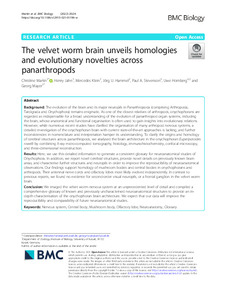| dc.date.accessioned | 2022-11-09T11:47:08Z | |
| dc.date.available | 2022-11-09T11:47:08Z | |
| dc.date.issued | 2022-01-25 | |
| dc.identifier | doi:10.17170/kobra-202211097088 | |
| dc.identifier.uri | http://hdl.handle.net/123456789/14240 | |
| dc.description.sponsorship | Gefördert durch den Publikationsfonds der Universität Kassel | ger |
| dc.language.iso | eng | |
| dc.rights | Namensnennung 4.0 International | * |
| dc.rights.uri | http://creativecommons.org/licenses/by/4.0/ | * |
| dc.subject | nervous system | eng |
| dc.subject | central body | eng |
| dc.subject | mushroom body | eng |
| dc.subject | olfactory lobe | eng |
| dc.subject | neuroanatomy | eng |
| dc.subject | glossary | eng |
| dc.subject.ddc | 570 | |
| dc.subject.ddc | 590 | |
| dc.title | The velvet worm brain unveils homologies and evolutionary novelties across panarthropods | eng |
| dc.type | Aufsatz | |
| dcterms.abstract | Background:
The evolution of the brain and its major neuropils in Panarthropoda (comprising Arthropoda, Tardigrada and Onychophora) remains enigmatic. As one of the closest relatives of arthropods, onychophorans are regarded as indispensable for a broad understanding of the evolution of panarthropod organ systems, including the brain, whose anatomical and functional organisation is often used to gain insights into evolutionary relations. However, while numerous recent studies have clarified the organisation of many arthropod nervous systems, a detailed investigation of the onychophoran brain with current state-of-the-art approaches is lacking, and further inconsistencies in nomenclature and interpretation hamper its understanding. To clarify the origins and homology of cerebral structures across panarthropods, we analysed the brain architecture in the onychophoran Euperipatoides rowelli by combining X-ray micro-computed tomography, histology, immunohistochemistry, confocal microscopy, and three-dimensional reconstruction.
Results:
Here, we use this detailed information to generate a consistent glossary for neuroanatomical studies of Onychophora. In addition, we report novel cerebral structures, provide novel details on previously known brain areas, and characterise further structures and neuropils in order to improve the reproducibility of neuroanatomical observations. Our findings support homology of mushroom bodies and central bodies in onychophorans and arthropods. Their antennal nerve cords and olfactory lobes most likely evolved independently. In contrast to previous reports, we found no evidence for second-order visual neuropils, or a frontal ganglion in the velvet worm brain.
Conclusion:
We imaged the velvet worm nervous system at an unprecedented level of detail and compiled a comprehensive glossary of known and previously uncharacterised neuroanatomical structures to provide an in-depth characterisation of the onychophoran brain architecture. We expect that our data will improve the reproducibility and comparability of future neuroanatomical studies. | eng |
| dcterms.accessRights | open access | |
| dcterms.creator | Martin, Christine | |
| dcterms.creator | Jahn, Henry | |
| dcterms.creator | Klein, Mercedes | |
| dcterms.creator | Hammel, Jörg U. | |
| dcterms.creator | Stevenson, Paul A. | |
| dcterms.creator | Homberg, Uwe | |
| dcterms.creator | Mayer, Georg | |
| dc.relation.doi | doi:10.1186/s12915-021-01196-w | |
| dc.subject.swd | Bärtierchen | ger |
| dc.subject.swd | Stummelfüßer | ger |
| dc.subject.swd | Nervensystem | ger |
| dc.subject.swd | Neuroanatomie | ger |
| dc.subject.swd | Gliederfüßer | ger |
| dc.subject.swd | Tierphysiologie | ger |
| dc.subject.swd | Glossar | ger |
| dc.type.version | publishedVersion | |
| dcterms.source.identifier | eissn:1741-7007 | |
| dcterms.source.journal | BMC Biology | eng |
| dcterms.source.volume | Volume 20 | |
| kup.iskup | false | |
| dcterms.source.articlenumber | 26 | |


